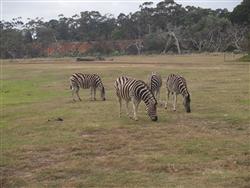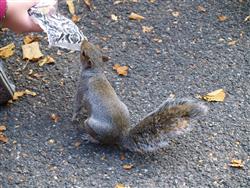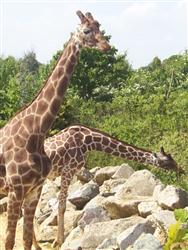A NEED FOR WILDLIFE CONSERVATION
The Worldwide Fund for Nature (WWF), founded in 1961 was one of the first organisations to recognise the need to conserve nature on a global scale. Although species extinction can be a natural process, in many countries species have become extinct either directly or indirectly due to human impact. At present there are around 17,000 plant and animal species worldwide that are known to be threatened with extinction. There are likely to be many more as less than 3% of the world’s species have been assessed for the IUCN Red List of Threatened Species.
In the last 500 years, human activity is known to have lead to the extinction of at least 870 species. Australia is a good example of the negative impact humans have on animal species. It has been colonised by Europeans for just over 200 years and has the most rapid rate of species extinction, with 27 animal species becoming extinct during this period. Scientists have attributed the rapid loss of biodiversity to this extinction rate. This loss of biodiversity is mainly a result of clearing by humans for agriculture and urban development. Humans can impact species and biodiversity in various other ways, including unsustainable harvesting, pollution, introduction of alien species and the degradation and destruction of habitat.
The scope of this course goes beyond wildlife conservation to include many different aspects of the environment and animals.
See below for your selection of modules.
Modules
Note that each module in the Qualification -Certificate in Environmental and Animal Studies is a short course in its own right, and may be studied separately.
The Need for Animal Conservation
 The IUCN Red List of 2009 identified more than 17,291 of 47,677 species assessed are currently threatened with extinction. This is around 36% of those assessed. There are 1.8 million recognised species on earth. However, the health and status of most of these species has not yet been assessed.
The IUCN Red List of 2009 identified more than 17,291 of 47,677 species assessed are currently threatened with extinction. This is around 36% of those assessed. There are 1.8 million recognised species on earth. However, the health and status of most of these species has not yet been assessed.
Amphibians appear to be facing the greatest threat, with around 30% of the 6 285 assessed species in danger of extinction. The deadly chytrid fungus (mentioned in lesson 1) is blamed for the extinction of the Kihansi Spray Toad (Nectophrynoides asperginis) in the wild within the last year.
Factors that lead to species loss worldwide include habitat loss, disease, overexploitation, invasive species, climatic changes, and pollution. It is usually a combination of some of these factors that lead to the extinction of a species. Below is a graph showing the percentage of species threatened by various causes. Although this data is from 1998, the trend has remained the same over time. As you can see, habitat loss is the major threat to plant and animal species worldwide.
In 2009, the number of species falling into each of these categories on the IUCN Red List
Status of Endangered Species were:
• Extinct: 809
• Extinct in wild: 66
• Critically endangered: 3 325 (257 of these species are considered possibly extinct)
• Endangered: 4 891
• Vulnerable to Extinction: 9 075
• Near Threatened: 3 650
SPECIES VULNERABILITY TO ENDANGERMENT
Although human impacts are generally the major cause of species extinction, there are observable characteristics in species that can make them more vulnerable to extinction. These include rarity, ability to disperse, degree of specialisation, population variability, their trophic level, life span and reproductive rate.
Rarity
In general, rare species are more susceptible to extinction than more common species. This may seem fairly straight forward, however, it is not as simple as it appears. Some more common species might be more susceptible to changes in climate. The concept of rarity depends on three factors – geographic range, size of habitat and size of the local population. Species are usually considered rare if they are found in only one geographic area or particular type of habitat. However, a species that may be widespread but at a very low density can also be considered rare (such as the koala in the western extent of its range). In these situations the management of habitat for conservation is more likely to be successful for species restricted to one area of type of habitat rather than widely dispersed species.
Ability to Disperse
Those species that are able to migrate between fragments of habitat are more likely to survive and less susceptible to extinction. Many forest species of birds show limited abilities to disperse into other forest fragments and are therefore more likely to become endangered.
Degree of Specialisation
Plants and animals that have specialised habitat requirements are generally more susceptible to endangerment. For example, the panda of China and the koala of Australia have extremely specialised diets which puts them at a higher risk of extinction.
Population Variability
Species that have relatively stable populations can be less prone to extinction than other species. Species that have big cycle changes in population size such as Lemmings are thought to be more susceptible to extinction.
Trophic Level
Those animals occupying higher trophic levels usually have smaller populations, such as the Californian Condor. These species are reliant on the presence of species in the lower trophic levels to meet their energy requirements. These two factors make these species more susceptible to extinction.
Life Span
Those species that have a shorter life span are more likely to become extinct. Species that are longer lived are more likely to live through ecological hardships to reproduce in later years, whereas shorter-lived species may not. The Northern Quoll (Dasyurus hallucatus) of Australia is one example of a short-lived species that has become endangered due to its inability to maintain a sustainable number of breeding adults to compensate for reduced numbers due to habitat loss and increased predation.
Reproductive Rate
Population growth will affect a species’ susceptibility to extinction. Those species that are able to reproduce and breed quickly are generally more likely to recover from population crashes. Small mammals such as mice are able to reproduce at a higher rate, which makes them less susceptible. Species such as the Passenger Pigeon of the United States laid only one egg per year, this, in conjunction with overexploitation contributed to their decline.
Those species with a combination of these traits are more susceptible to extinction. For example, the salamanders are often long-lived, slow-breeding species with a limited ability to disperse over long distances. There has been a sharp decline in the number of salamander species worldwide. Some species that had been surveyed in the forests of southern Mexico and Guatemala in the 1970’s are now extinct, whilst other population numbers are decreasing rapidly.
____________________________________________________________________________________________
MORE DETAILS ON THE CORE MODULES -
WILDLIFE MANAGEMENT
There are 9 lessons as follows:
1. Introduction to Wildlife Management
-
What is Wildlife Management
-
Approaches to Wildlife Management (Preservation, Conservation, Management)
-
Purpose of Wildlife Management
-
Goals
-
Decision Making (Who makes decisions, Making good decisions)
-
Needs of Wildlife
-
What’s a Good Habitat
-
Limiting factor
-
Carrying capacity
-
Landscape Fragmentation
-
Habitat Diversity
-
Arrangement
-
Biological Control
-
Integrated Pest Management
2. Wildlife Ecology
-
Ecology (Mutualism, Commensalisms, Competition, Predation, parasitism, herbivore)
-
Behavioural Ecology
-
Population Ecology
-
Community Ecology
-
Ecosystem Ecology
-
Interactions within a Community
-
Competition
-
Predation
-
Parasitism
-
Commensalism
-
Mutualism
-
The Food Web (Derital Web, Grazing Web, Trophic Levels)
-
Energy Flow
-
Imbalances

3. Wildlife Habitats
-
Introduction
-
Classification of Habitats
-
Biomes, Ecosystems, Microclimates
-
Timbered Biomes (Boreal Forest/ Taiga, Temperate Forest, Tropical Forest, Woodland)
-
Scrubland
-
Tropical Savannah
-
Temperate Grassland
-
Arctic Tundra
-
Alpine
-
Semi-desert
-
Desert
-
Man Made Biomes (Urban, Agricultural)
-
Wet Biomes (Mangrove, Rivers, Benthos, Pelagic, Continental Shelf, Coral Reef,
-
Animal Use of Features in Biomes (Trees, Logs, Surface Rocks and Ground Cover, Creeks, Wetlands and Dams)
-
Case Studies
-
Changes to Habitats (Physical, Biological, Pollution)
-
Water for Wildlife
-
Site Water Points
-
Managing Trees
-
Deforestation
-
Afforestation
4. Population Dynamics
-
Populations
-
Birth or Fecundity Rate
-
Death or Mortality Rate
-
Growth Rate
-
Life Tables
-
Cohort or Dynamic Life Tables (Age Specific)
-
Static or Time Specific Life Tables
-
Rodents
-
Squirrels
-
Rabbits
-
Mosquitoes
-
Grasshoppers
-
Case Studies of different animals in different countries

5. Carrying Capacity
-
Introduction
-
Exponential Population Growth
-
What is Carrying Capacity
-
Fisheries stock management (stock Identification, assessment, biomass)
-
Stock Management Methods
6. Wildlife Censuses
-
Introduction and census types
-
Total Counts
-
Sampling (Simple Random, Stratified Random, Systemic, Two Stage, Double sampling)
-
Accuracy vs Precision
-
Bias Errors
-
Aerial Surveys
-
Trapping
-
Transects
-
Indirect Methods
-
Mark-Recapture method
-
Roadside and Call Counts
-
Mapping
-
Sampling methods for specific types of animals (ie. Fish, Amphibians, Reptiles, Birds, Invertebrates, Mammals etc.)
-
Animal Ethics
-
Case Study
7. Wildlife Management Techniques
-
Habitat Modification
-
 Fire
Fire
-
Vegetation Management
-
Predator Control
-
Habitat Features
-
Seeding
-
Population Monitoring
-
Captive Breeding and Release
-
Culling and Cropping
-
Control of pest or undesirable wildlife species
-
Control Objectives
-
Effects of Control
-
Control Techniques (Manipulating mortality, fertility, Genetic Engineering, indirect methods)
8. Wildlife Management Law and Administration
9. Wildlife Management Case Study Research Project
Problem Based Learning Project with following aims:
-
Identify the objectives of a management program for an endangered species.
-
Determine appropriate techniques for carrying out a census of an endangered species.
-
Identify techniques for increasing the population of the endangered species.
-
Identify pest species and their undesirable effect on the endangered species of bird.
-
Identify techniques for reducing the undesirable impacts of the pest species on the endangered bird.
-
Present a management plan in a form that is appropriate for use by wildlife worker.
Aims
- Develop a concept of how man manages wildlife populations in different situations around the world.
- Understand and discuss the principles of wildlife ecology.
- Understand wildlife habitats and their importance to managing wildlife.
- Explain how populations of any one species change and adapt to variations in their environment.
- Understand carrying capacity and its importance in managing wildlife populations.
- Explain a range of different methods used to determine the number of individuals in a wildlife population.
- Discuss a range of different wildlife management techniques.
- To understand the potentials and limitations of legal and administrative initiatives, in the pursuance of more effective wildlife management.
- Examine a specific wildlife management case of interest to the student.
What You Will Do
- Network with individuals and organisations involved in wildlife management (over the internet, by phone, mail or in person -There's lots of flexibility in how you do this!)
- Research pest species of wildlife and endangered or threatened species of wildlife.
- Visit a natural area in your locality and observe the organisms in the area and their interactions with each other and the environment.
- Explain what trophic levels are and how energy flows between them.
- Define habitat, biome, vegetation formation and feeding radius.
- Visit a zoo, wildlife park, game reserve, pet shop, fauna sanctuary or other place where wild animals are kept in captivity to observe the animals in their captive surroundings and compare these with their native surroundings.
- Identify a predator-prey relationship between two species in a local ecosystem and make predictions about changes to this relationship.
- Research the difference between r and K strategists in animals.
- Design a wildlife survey using a suitable sampling technique. Write this survey up as a mini scientific report containing an Abstract/Project Summary, Methods and materials section, Results/Discussion and Conclusion.
- Research the success of one wildlife program where wildlife have been bred in captivity and then released.
- Draw up a table that lists the advantages and disadvantages of allowing hunting to proceed in game parks where the animals being hunted are native to the area.
- Telephone or contact a wildlife management agency in your area to determine the relevant local, regional, national and international laws that apply to wildlife in your locality.
- Prepare a report of no less than 1000 words on a population of animals surveyed during the course.
ENVIRONMENTAL STUDIES
There are 6 lessons in this course:
- Living Things
- Classification of plants and animals
- identifying living organisms
- using identification keys
- Basic Ecology
- Populations
- communities
- ecosystems
- constituents of ecosystem
- the ecosphere
- the web of life
- habitats and niches
- humans in the environment.
- Global Environmental Systems
- The Earth’s structure
- the atmosphere
- climatic systems
- Gaia theory
- the carbon dioxide cycle
- El Nino.
- Environmental Problems
- Deforestation
- loss of agricultural land
- loss of biological diversity
- loss of water
- loss of non renewable resources
- environmental weeds
- the Greenhouse Effect
- Ozone depletion
- ozone as a Greenhouse gas
- Conservation
- The definition and goals of conservation
- the history of conservation
- natural resources (renewable and non renewable).
- Acting Locally: Thinking Globally
- Humans and water
- how to minimize water usage
- energy use in the home
- reducing household waste
- domestic transport and its affect on pollution
- building materials and their environmental impact.
Each lesson culminates in an assignment which is submitted to the school, marked by the school's tutors and returned to you with any relevant suggestions, comments, and if necessary, extra reading.
Aims
- To understand the binomial system of classifying living things
- To understand the use of keys to identify living things
- To grasp the basics of ecology (the relationships between living organisms and their environment)
- To have a basic grounding in Earth Science and an understanding of global environmental systems
- To understand the Earth’s major environmental problems and how they have come about
- To gain an understanding of conservation and its importance to individuals and the world
- To learn a range of ways to reduce the environmental impact of ones’ actions at home and globally
What You Will Do
- Classify a range of living organisms in your locality
- Identify the genus and species names of plants in a nursery
- Compose a food web for your local area
- Carry out basic research into the weather in your area and what affects it
- Carry out in depth research into at least one major environmental problem
- Contact three conservation organisations to determine the issues they deal with
- Survey a building to determine the types of building materials used
- Design an environmentally friendly house
ENVIRONMENTAL AND ANIMAL STUDIES COURSE BY DISTANCE LEARNING
This unique course offers students the opportunity to study environmental and animal related courses in this six module certificate.
* Study at home with help from our highly experienced tutors.
* Learn in your own time.
* Learn about the environment and the human impact on it.
* Study animal health and wildlife.
* A fascinating course for anyone interesting in helping animals and our environment.
 EBOOKS
EBOOKSAlso available - Animal Health Care eBook. Find out more by
clicking here.
